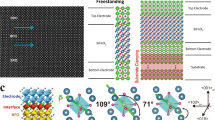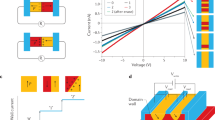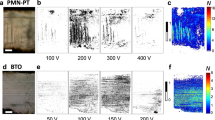Abstract
Memristive materials and devices, which enable information storage and processing on one and the same physical platform, offer an alternative to conventional von Neumann computation architectures. Their continuous spectra of states with intricate field-history dependence give rise to complex dynamics, the spatial aspect of which has not been studied in detail yet. Here, we demonstrate that ferroelectric domain switching induced by a scanning probe microscopy tip exhibits rich pattern dynamics, including intermittency, quasiperiodicity and chaos. These effects are due to the interplay between tip-induced polarization switching and screening charge dynamics, and can be mapped onto the logistic map. Our findings may have implications for ferroelectric storage, nanostructure fabrication and transistor-less logic.
This is a preview of subscription content, access via your institution
Access options
Subscribe to this journal
Receive 12 print issues and online access
$209.00 per year
only $17.42 per issue
Buy this article
- Purchase on Springer Link
- Instant access to full article PDF
Prices may be subject to local taxes which are calculated during checkout






Similar content being viewed by others
References
Gleick, J. Chaos: Making a New Science (Penguin Books, 2008).
Strogatz, S. H. Nonlinear Dynamics And Chaos: With Applications To Physics, Biology, Chemistry, And Engineering (Westview, 2001).
Bunde, A. & Havlin, S. Fractals and Disordered Systems (Springer, 2012).
Havlin, D. Diffusion and Reactions in Fractals and Disordered Systems (Cambridge Univ. Press, 2005).
Barabasi, A-L. & Stanley, H. E. Fractal Concepts in Surface Growth (Cambridge Univ. Press, 1995).
Abarbanel, H. D. I., Brown, R., Sidorowich, J. J. & Tsimring, L. S. The analysis of observed chaotic data in physical systems. Rev. Mod. Phys. 65, 1331–1392 (1993).
Ott, E., Grebogi, C. & Yorke, J. A. Controlling chaos. Phys. Rev. Lett. 64, 1196–1199 (1990).
Garstecki, P., Fuerstman, M. J. & Whitesides, G. M. Oscillations with uniquely long periods in a microfluidic bubble generator. Nature Phys. 1, 168–171 (2005).
Gruverman, A. & Kholkin, A. Nanoscale ferroelectrics: Processing, characterization and future trends. Rep. Prog. Phys. 69, 2443–2474 (2006).
Kalinin, S. V., Morozovska, A. N., Chen, L. Q. & Rodriguez, B. J. Local polarization dynamics in ferroelectric materials. Rep. Prog. Phys. 73, 056502 (2010).
Rodriguez, B. J. et al. Domain growth kinetics in lithium niobate single crystals studied by piezoresponse force microscopy. Appl. Phys. Lett. 86, 012906 (2005).
Woo, J. et al. Quantitative analysis of the bit size dependence on the pulse width and pulse voltage in ferroelectric memory devices using atomic force microscopy. J. Vac. Sci. Technol. B 19, 818–824 (2001).
Tybell, T., Paruch, P., Giamarchi, T. & Triscone, J. M. Domain wall creep in epitaxial ferroelectric Pb(Zr0.2Ti0.8)O3 thin films. Phys. Rev. Lett. 89, 097601 (2002).
Bonnell, D. A., Kalinin, S. V., Kholkin, A. L. & Gruverman, A. Piezoresponse force microscopy: A window into electromechanical behavior at the nanoscale. MRS Bull. 34, 648–657 (2009).
Tanaka, K. et al. Scanning nonlinear dielectric microscopy nano-science and technology for next generation high density ferroelectric data storage. Jpn J. Appl. Phys. 47, 3311–3325 (2008).
Shen, J. et al. Study of asymmetric charge writing on Pb(Zr,Ti)O3thin films by Kelvin probe force microscopy. Appl. Surf. Sci. 252, 8018–8021 (2006).
Franke, K., Besold, J., Haessler, W. & Seegebarth, C. Modification and detection of domains on ferroelectric PZT films by scanning force microscopy. Surf. Sci. 302, L283–L288 (1994).
Morozovska, A. N. et al. Piezoresponse force spectroscopy of ferroelectric-semiconductor materials. J. Appl. Phys. 102, 114108 (2007).
Tagantsev, A. K., Cross, L. E. & Fousek, J. Domains in Ferroic Crystals and Thin Films (Springer, 2010).
Kalinin, S. V. & Bonnell, D. A. Screening phenomena on oxide surfaces and its implications for local electrostatic and transport measurements. Nano Lett. 4, 555–560 (2004).
Kumar, A. et al. Probing surface and bulk electrochemical processes on the LaAlO3–SrTiO3 interface. ACS Nano 6, 3841–3852 (2012).
Watanabe, Y., Okano, M. & Masuda, A. Surface conduction on insulating BaTiO3 crystal suggesting an intrinsic surface electron layer. Phys. Rev. Lett. 86, 332–335 (2001).
Fridkin, V. M. Ferroelectric Semiconductors (Springer, 1980).
Kalinin, S. V. & Bonnell, D. A. Local potential and polarization screening on ferroelectric surfaces. Phys. Rev. B 63, 125411 (2001).
Kalinin, S. V., Johnson, C. Y. & Bonnell, D. A. Domain polarity and temperature induced potential inversion on the BaTiO3(100) surface. J. Appl. Phys. 91, 3816–3823 (2002).
Son, J. Y., Kyhm, K. & Cho, J. H. Surface charge retention and enhanced polarization effect on ferroelectric thin films. Appl. Phys. Lett. 89, 092907 (2006).
Kim, Y., Hong, S., Kim, S. H. & No, K. Surface potential of ferroelectric domain investigated by Kelvin force microscopy. J. Electroceram. 17, 185–188 (2006).
Rodriguez, B. J., Jesse, S., Baddorf, A. P., Kim, S. H. & Kalinin, S. V. Controlling polarization dynamics in a liquid environment: From localized to macroscopic switching in ferroelectrics. Phys. Rev. Lett. 98, 247603 (2007).
Rodriguez, B. J., Jesse, S., Baddorf, A. P. & Kalinin, S. V. High resolution electromechanical imaging of ferroelectric materials in a liquid environment by piezoresponse force microscopy. Phys. Rev. Lett. 96, 237602 (2006).
Morozovska, A. N., Eliseev, E. A. & Kalinin, S. V. The piezoresponse force microscopy of surface layers and thin films: Effective response and resolution function. J. Appl. Phys. 102, 074105 (2007).
Morozovska, A. N., Eliseev, E. A., Bravina, S. L. & Kalinin, S. V. Resolution-function theory in piezoresponse force microscopy: Wall imaging, spectroscopy, and lateral resolution. Phys. Rev. B 75, 174109 (2007).
Kalinin, S. V. et al. Quantitative determination of tip parameters in piezoresponse force microscopy. Appl. Phys. Lett. 90, 212905 (2007).
Eliseev, E. A., Kalinin, S. V., Jesse, S., Bravina, S. L. & Morozovska, A. N. Electromechanical detection in scanning probe microscopy: Tip models and materials contrast. J. Appl. Phys. 102, 014109 (2007).
Molotskii, M. I. & Shvebelman, M. M. Dynamics of ferroelectric domain formation in an atomic force microscope. Phil. Mag. 85, 1637–1655 (2005).
Aravind, V. R. et al. Correlated polarization switching in the proximity of a 180 degrees domain wall. Phys. Rev. B 82, 024111 (2010).
Di Ventra, M. & Pershin, Y. V. The parallel approach. Nature Phys. 9, 200–202 (2013).
Pershin, Y. V. & Di Ventra, M. Memory effects in complex materials and nanoscale systems. Adv. Phys. 60, 145–227 (2011).
Spaldin, N. A. & Fiebig, M. The renaissance of magnetoelectric multiferroics. Science 309, 391–392 (2005).
Wu, W. D., Horibe, Y., Lee, N., Cheong, S. W. & Guest, J. R. Conduction of topologically protected charged ferroelectric domain walls. Phys. Rev. Lett. 108, 077203 (2012).
Seidel, J. et al. Conduction at domain walls in oxide multiferroics. Nature Mater. 8, 229–234 (2009).
Acknowledgements
A part of this research (S.J., E.S., A.K., S.V.K.) was conducted at the Center for Nanophase Materials Sciences, which is sponsored at Oak Ridge National Laboratory by the Scientific User Facilities Division, Office of Basic Energy Sciences, US Department of Energy. A.V.I. and V.Y.S. acknowledge CNMS user proposal, RFBR (Grants 11-02-91066-CNRS-a, 13-02-01391-a, 13-02-96041-r-Ural-a), Ministry of Education and Science (Contract 14.513.12.0006). Y.V.P. was supported by National Science Foundation grant ECCS-1202383. The authors gratefully acknowledge Y. Wu (Tufts University) for posting the original version of the chaos analysis codes on the MathWorks website. A.N.M. and E.A.E. acknowledge the support through the bilateral SFFR-NSF project (US National Science Foundation under NSF-DMR-1210588 and State Fund of Fundamental State Fund of Fundamental Research of Ukraine, grant UU48/002). We gratefully acknowledge A. K. Tagantsev (EPFL) for valuable advice on the role of screening phenomena on ferroelectric phase stability, and B. Sumpter and S. Pennycook (ORNL) for illuminating discussions. S.V.K. and V.Y.S. would like to acknowledge many useful discussions with the late Y. D. Tretyakov (Moscow State University, Russia), who introduced them to the field of chaos and fractals in solid-state systems and inspired this work, and dedicate this paper to him in memoriam.
Author information
Authors and Affiliations
Contributions
A.V.I. obtained and analysed the experimental data. S.V.K. proposed the concept and wrote (with A.N.M. and A.V.I.) the paper. E.S. and A.K. assisted in development of the experimental set-up and development of modelling codes. A.N.M. and E.A.E. developed theoretical analysis of the screening process and derived recursive formulae for domains in the chain. S.J. wrote the codes for simulating chaotic dynamics. Y.V.P. analysed the applications of the observed phenomena in information technology. S.V.K. and V.Y.S. directed the research.
Corresponding authors
Ethics declarations
Competing interests
The authors declare no competing financial interests.
Supplementary information
Supplementary Information
Supplementary Information (PDF 1408 kb)
Rights and permissions
About this article
Cite this article
Ievlev, A., Jesse, S., Morozovska, A. et al. Intermittency, quasiperiodicity and chaos in probe-induced ferroelectric domain switching. Nature Phys 10, 59–66 (2014). https://doi.org/10.1038/nphys2796
Received:
Accepted:
Published:
Issue Date:
DOI: https://doi.org/10.1038/nphys2796
This article is cited by
-
Self-organization of ferroelectric domains induced by water and reinforced via ultrasonic vibration
Communications Materials (2023)
-
Local and correlated studies of humidity-mediated ferroelectric thin film surface charge dynamics
npj Computational Materials (2021)
-
The future of ferroelectric field-effect transistor technology
Nature Electronics (2020)
-
Non-conventional mechanism of ferroelectric fatigue via cation migration
Nature Communications (2019)
-
Mixed-precision in-memory computing
Nature Electronics (2018)



